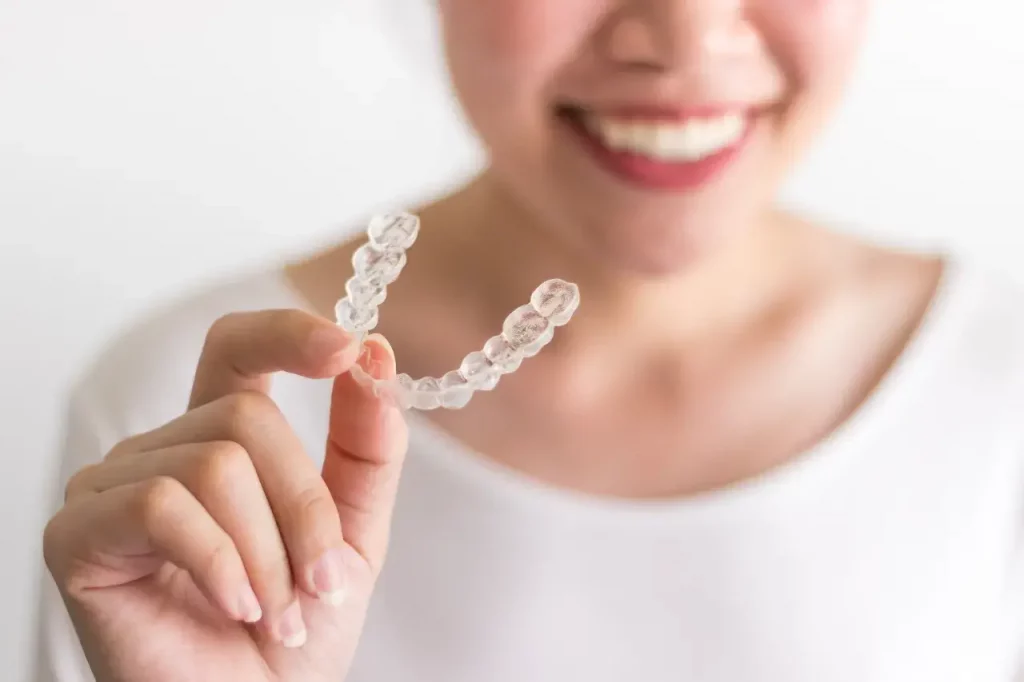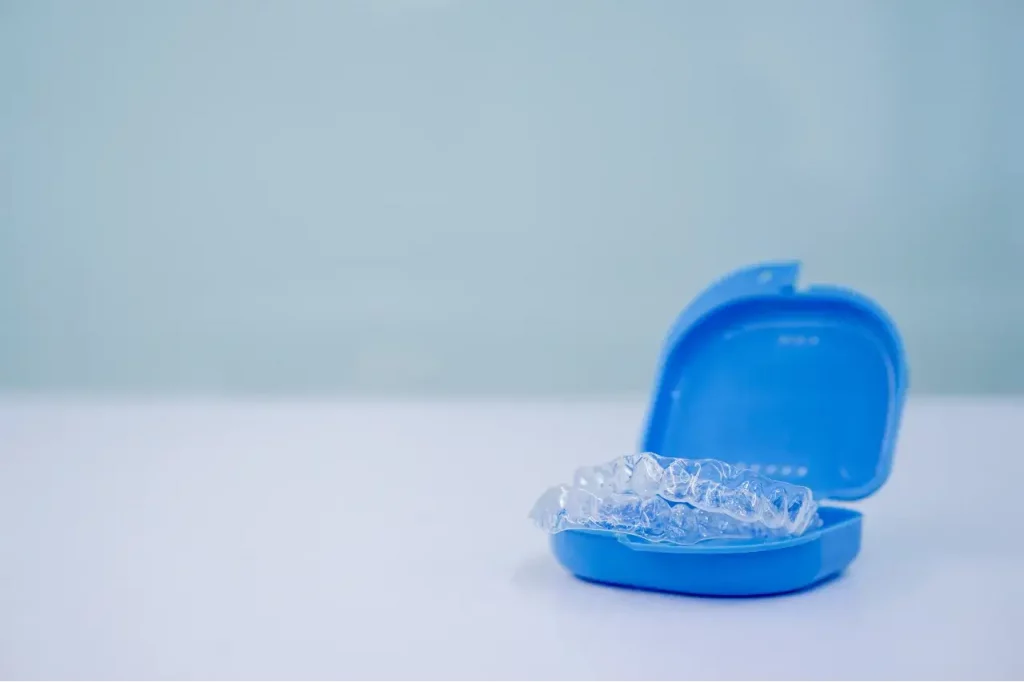When you wear a dental night guard while you sleep, you can reduce tooth damage caused by grinding your teeth at night. But which type of night guard will work best for you? There are custom-made and over-the-counter (OTC) night guards that provide the same protection. While an over-the-counter night guard can be cheaper than a custom-made one, it’s worth considering the quality of the materials used, how well the guard fits, and what to expect in terms of comfort before you make a decision.

A night guard is a retainer-like device worn over either your top or bottom teeth while sleeping. Doing so prevents your teeth from grinding on top of each other. A custom-made night guard also has many names, but dentists will always call it either a mouth guard, oral appliance, occlusal guard, bite splint, dental guard, or nocturnal bite plate.
Do you grind your teeth? Do you wake up in the morning with neck pain? If so, then wearing a guard while you sleep can prevent damage to your teeth and relieve the pain associated with the condition. Teeth grinding and clenching, also known as bruxism, can result in pain and damage to your teeth and jaw if not treated.
A night guard is a removable oral appliance that protects your teeth from grinding at night. The device is made of plastic or acrylic and fits snugly into place, generally on the upper teeth. Most people who grind their teeth do not even know they are doing it until someone mentions it or they experience pain. One of the first signs that someone might have bruxism is waking up with neck pain or difficulty chewing certain foods in the morning. In some cases, patients do not know they have severe tooth wear until they visit the dentist, have broken teeth, have sudden tooth pain due to a process called attrition, or experience tooth loss.
What causes bruxism is unclear, but many people believe it can be linked to stress, anxiety, crooked teeth, an abnormal bite, snoring, smoking, alcohol use, caffeine, and sleep apnea. According to the American Sleep Association (ASA), symptoms of bruxism include:
If your dentist has identified bruxism as the cause of your dental problems, there are two types of night guards to help prevent further tooth enamel damage.
Over-the-counter night guard – There are two basic types of OTC night guards / mouth guards. The first type is the one-size-fits-all variety, designed to fit most mouth types. The second type is the boil-and-bite night guard, which must be softened with heat and then molded into shape to fit your teeth.
Custom night guard – An alternative to a general-purpose over-the-counter mouth guard is one made by your family dentist that fits you perfectly. For the best night guard, your dentist can create a custom guard by taking a mold of your teeth, where the night guard will be durable, comfortable, and lightweight enough to wear at night without interrupting your sleep.
Here are some pros and cons of whether an over-the-counter night guard or a custom night guard will work for you.
The biggest benefit to an over-the-counter night guard is they are less expensive than one made by a dentist. If you don’t have time to visit the dentist or are simply in a hurry to receive treatment, you can get your OTC mouth guard at almost any pharmacy, online retailer, or retailer store. Here are some benefits why some may choose one over a custom-made one.
In general, over-the-counter night guards are usually thicker than custom-fitted ones, and many people find them too thick to sleep comfortably with. The biggest drawback is that the impression needs to be done correctly otherwise, your night guard will not fit your mouth correctly. Other drawbacks include:
The cost of getting a night guard from your dentist may be higher than choosing a less expensive option. However, when you add in the benefits of getting a customized night guard, this alternative might be a better fit. These benefits include:
Night guards are highly recommended for people who suffer from bruxism. However, there are some drawbacks.
Your bite is an intricate system made up of teeth, bones, and muscles, and it’s unique to you. If your dentist recommends a night guard to prevent your teeth from wearing down further due to a simple bite problem, using an over-the-counter night guard may cause it to worsen from a simple bite problem to a complex case of TMJ.
When using an over-the-counter night guard, there are many variables that may cause it to worsen, such as a bad impression taken at home or the quality of material used is not sufficient. When getting a night guard from the dentist, your night guard will be made to fit your mouth.
You should visit your general dentist even if you’re planning on getting an over-the-counter night guard. The reason is that the cause of your teeth grinding can be something other than bruxism or something even more severe. Without proper diagnosis, you will temporarily mask the symptom until the problem worsens.
Night guards are essential for protecting your teeth from nighttime damage, but it is also important to keep them clean. Here are a few tips for keeping your night guard clean:
If you have dental restorations such as dental implants, crowns, dentures, or bridges, your dentist will recommend that you wear a nightguard to help protect your teeth. Wearing a properly fitted device like a mouth guard at night will help protect your teeth from damage caused by excessive contact. Not doing so can cause serious jaw joint problems, headaches, and more.

If you have nightly problems like teeth clenching, grinding, or jaw pain, talk to your dentist about effective, safe, long-term solutions for TMJ, sleep apnea, and other dental issues. Whether you decide one or the other, if using a dental appliance is recommended, you should get one to protect your teeth from further damage. If you’re looking for professional treatment, we offer a variety of treatments for nighttime teeth grinding and discomfort in our Fairview office.
At Sloan Creek Dental, we know that a healthy smile is important to the quality of your life. That’s why we provide top-quality dental services and beautiful smiles at an affordable price. If you have any questions about your oral health or other treatment plans, call us at 972-468-1440 today to schedule your consultation with Dr. Feng.
Our dental office is located in Fairview, Texas, and our patients visit us from across the surrounding areas, including Allen, Plano, McKinney, and Lucas.
We firmly believe that the internet should be available and accessible to anyone, and are committed to providing a website that is accessible to the widest possible audience, regardless of circumstance and ability.
To fulfill this, we aim to adhere as strictly as possible to the World Wide Web Consortium’s (W3C) Web Content Accessibility Guidelines 2.1 (WCAG 2.1) at the AA level. These guidelines explain how to make web content accessible to people with a wide array of disabilities. Complying with those guidelines helps us ensure that the website is accessible to all people: blind people, people with motor impairments, visual impairment, cognitive disabilities, and more.
This website utilizes various technologies that are meant to make it as accessible as possible at all times. We utilize an accessibility interface that allows persons with specific disabilities to adjust the website’s UI (user interface) and design it to their personal needs.
Additionally, the website utilizes an AI-based application that runs in the background and optimizes its accessibility level constantly. This application remediates the website’s HTML, adapts Its functionality and behavior for screen-readers used by the blind users, and for keyboard functions used by individuals with motor impairments.
If you’ve found a malfunction or have ideas for improvement, we’ll be happy to hear from you. You can reach out to the website’s operators by using the following email
Our website implements the ARIA attributes (Accessible Rich Internet Applications) technique, alongside various different behavioral changes, to ensure blind users visiting with screen-readers are able to read, comprehend, and enjoy the website’s functions. As soon as a user with a screen-reader enters your site, they immediately receive a prompt to enter the Screen-Reader Profile so they can browse and operate your site effectively. Here’s how our website covers some of the most important screen-reader requirements, alongside console screenshots of code examples:
Screen-reader optimization: we run a background process that learns the website’s components from top to bottom, to ensure ongoing compliance even when updating the website. In this process, we provide screen-readers with meaningful data using the ARIA set of attributes. For example, we provide accurate form labels; descriptions for actionable icons (social media icons, search icons, cart icons, etc.); validation guidance for form inputs; element roles such as buttons, menus, modal dialogues (popups), and others. Additionally, the background process scans all of the website’s images and provides an accurate and meaningful image-object-recognition-based description as an ALT (alternate text) tag for images that are not described. It will also extract texts that are embedded within the image, using an OCR (optical character recognition) technology. To turn on screen-reader adjustments at any time, users need only to press the Alt+1 keyboard combination. Screen-reader users also get automatic announcements to turn the Screen-reader mode on as soon as they enter the website.
These adjustments are compatible with all popular screen readers, including JAWS and NVDA.
Keyboard navigation optimization: The background process also adjusts the website’s HTML, and adds various behaviors using JavaScript code to make the website operable by the keyboard. This includes the ability to navigate the website using the Tab and Shift+Tab keys, operate dropdowns with the arrow keys, close them with Esc, trigger buttons and links using the Enter key, navigate between radio and checkbox elements using the arrow keys, and fill them in with the Spacebar or Enter key.Additionally, keyboard users will find quick-navigation and content-skip menus, available at any time by clicking Alt+1, or as the first elements of the site while navigating with the keyboard. The background process also handles triggered popups by moving the keyboard focus towards them as soon as they appear, and not allow the focus drift outside of it.
Users can also use shortcuts such as “M” (menus), “H” (headings), “F” (forms), “B” (buttons), and “G” (graphics) to jump to specific elements.
We aim to support the widest array of browsers and assistive technologies as possible, so our users can choose the best fitting tools for them, with as few limitations as possible. Therefore, we have worked very hard to be able to support all major systems that comprise over 95% of the user market share including Google Chrome, Mozilla Firefox, Apple Safari, Opera and Microsoft Edge, JAWS and NVDA (screen readers), both for Windows and for MAC users.
Despite our very best efforts to allow anybody to adjust the website to their needs, there may still be pages or sections that are not fully accessible, are in the process of becoming accessible, or are lacking an adequate technological solution to make them accessible. Still, we are continually improving our accessibility, adding, updating and improving its options and features, and developing and adopting new technologies. All this is meant to reach the optimal level of accessibility, following technological advancements. For any assistance, please reach out to